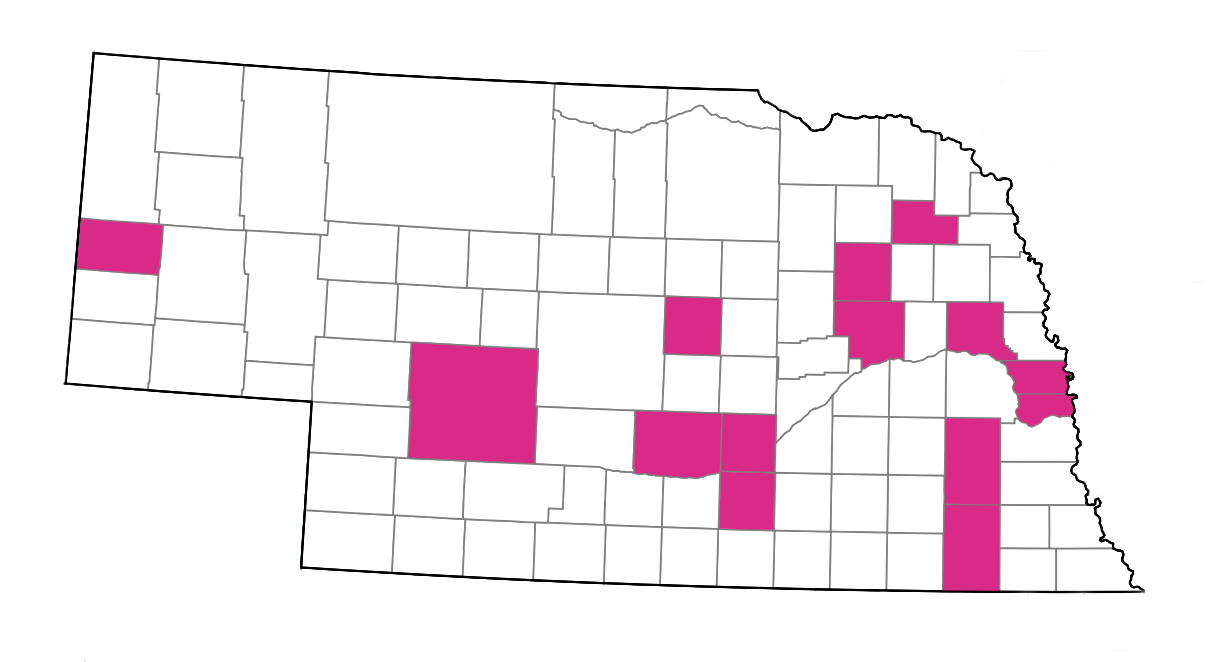In response to a growing crisis, Nebraska lawmakers are exploring avenues to strengthen and retain Nebraska’s healthcare workforce in rural and underserved areas.
As a voice for sexual and reproductive health–and at the request of Senator Merv Riepe–we penned a letter to the Health and Human Services Committee outlining current challenges, potential impacts, and opportunities to advance care through state-level policy solutions. Read on for a breakdown of this letter and to learn more.
The bottom line: Nebraska must find a path toward equitable access to high-quality reproductive care for all. To do this, a well-trained and supported workforce is absolutely essential.
_
Challenges and Opportunities

Map of Nebraska counties with an OB-GYN (2023). Fitzhugh Mullan Institute for Health Workforce Equity. Prescription Contraception Workforce Tracker. Washington, DC: George Washington University, 2025. https://www.gwhwi.org/reproductivehealth.html.
Sexual and reproductive healthcare provider shortages are a significant concern across Nebraska.
- The state’s panhandle region currently has only three OB-GYN providers.
- Nineteen rural Nebraska counties have no provider able to prescribe contraception (1).
- Further, Nebraska had a 25% drop (from 253 to 191) in OB-GYN medical residency applicants in 2024 and does not have a rural OB-GYN residency program (2)(3)(4).
With limited resources, heightened patient demand, and unstable funding, providers face barriers leading to high provider burnout and turnover (5)(6).
- Multiple clinics lost skilled providers during the COVID-19 pandemic, leaving gaps in knowledge and expertise.
- Many clinics operate with a single administrative staff member or have providers doing billing and administrative tasks.
- Providers often support multiple clinics to ensure ongoing access to this critical basic healthcare.

Map of Nebraska counties with providers that can prescribe contraception (2023). Fitzhugh Mullan Institute for Health Workforce Equity. Prescription Contraception Workforce Tracker. Washington, DC: George Washington University, 2025. https://www.gwhwi.org/reproductivehealth.html.
Declining public and private funding exacerbate the challenges. The Office of Population Affairs at the U.S. Department of Health and Human Services estimates that $1.38 billion would be required to fully meet current national needs. Title X has been flat funded at $286 billion annually for the past 10 years (7)(8).
This nationwide 55-year-old program has previously enjoyed strong bipartisan support; however, it is not included in the 2026 House HHS Appropriations Bill. We are now anticipating over $2 million in lost funding within Nebraska. With private funders unable to fill this gap, several rural clinics will close.
Impact on Patient Access
As clinics face workforce shortages, providers continue to grapple with the heightened sexual and reproductive healthcare needs of underserved Nebraskans. Patients face multiple economic and logistical barriers when attempting to access this care.

Map of Nebraska counties with providers that provide the pill, patch, and ring through Medicaid (2021). Qian (Eric) Luo, Yoon Hong Park, Taylor Gorak, Sara Luckenbill, Katie Webster, Julia Strasser. Medicaid Contraception Workforce Tracker. Fitzhugh Mullan Institute for Health Workforce Equity. Washington, DC: George Washington University, 2025. https://www.gwhwi.org/medicaid-tracker-contraception-workforce.html.
- Providers often split time between clinics, leading to limited appointment options and increased geographic distance between patients and providers
- Only 9.5% of providers that can prescribe IUDs in Nebraska accept Medicaid.
- Only 42.2% of providers that can prescribe birth control pills, patches, and/or rings accept Medicaid (1).
Our network uses a sliding fee scale to accommodate clients’ financial needs. With the uncertainty of continued Title X program funding and Medicaid eligibility changes, economic barriers are only compounding.
State-Level Policy Solutions
To ensure rural Nebraskans can access quality reproductive healthcare, Nebraska must support and value its sexual and reproductive health providers. Reproductive Health Collaborative recommends that Nebraska lawmakers:
- Appropriate funding to sexual and reproductive health services
- Ensure the right to family planning
To have healthy parents, families, and communities, we must ensure Nebraskans have access to high-quality sexual and reproductive care.
Beyond Sexual and Reproductive Health
To maximize community resources, our partners are connected with providers outside of the sexual and reproductive health scope. The current Nebraska Title X network includes:
- One hospital-affiliated site with access to primary care, either onsite or through internal referral
- One public health department
- Four standalone clinics
Across our network, we have implemented a “No Wrong Door” approach to ensure that we maximize our connections with patients. For example, if a mom comes for WIC, clinics ensure annual wellness checks are updated. If a patient comes in for contraception, they may also get their blood pressure checked, allowing providers to detect early warning signs of heart disease or other concerns (9).

Our Approach
Across our network, our approach ensures that patients receive the same quality care from Gering to Tecumseh. We’re maximizing resources by:
- Implementing an opt-out approach to STI testing
- Coordinating centralized education and outreach strategies and investing in education and outreach personnel
- Hosting a strong, statewide collaborative with streamlined, network-wide training
Stay Updated
Reproductive Health Collaborative is a 501(c)(3) committed to ensuring that all Nebraskans have equitable access to high-quality sexual and reproductive healthcare. We support this access and our partners by facilitating braided federal and private funding, serving as a trusted and approachable advisor, and advancing a statewide network. To stay updated on our work, connect with us online and join our email list.
_
References
(1) Fitzhugh Mallan Institute for Health Workforce Equity (2025). Prescription Contraception Workforce Tracker.
George Washington University. https://www.gwhwi.org/tracker-contraception-workforce.html
(2) Gentzler, S. (2024). One year after abortion law, fewer med students applying to become doctors in Nebraska.
Flatwater Free Press. https://flatwaterfreepress.org/one-year-after-abortion-law-fewer-med-students-applying-to-become-doctors-in-nebraska/
(3) National Resident Matching Program. (2024). NRMP and obstetrics and gynecology matches: History, 2024
match outcomes, and trend analyses. https://www.nrmp.org/wp-content/uploads/2024/05/NRMP-OB-GYNMatches.Pdf
(4) RuralGME.org (n.d.). Rural residency programs and rural rotation sites. https://www.ruralgme.org/rural-programs
(5) Sabbath, E. L., McKetchnie, S. M., Arora, K. S., & Buchbinder, M. (2024). US obstetrician-gynecologist’s perceived
impacts of post-Dobbs v Jackson state abortion bans. JAMA Network Open, 7(1), e2352109.
https://jamanetwork.com/journals/jamanetworkopen/fullarticle/2814017
(6) Gandi, J. C., Wai, P. S., Karick, H., & Dagona, Z. K. (2011). The role of stress and level of burnout in job
performance among nurses. Mental Health in Family Medicine, 8(3), 181-194.
https://pmc.ncbi.nlm.nih.gov/articles/PMC3314275/
(7) Office of Population Affairs. (n.d.). Title X program funding history [Archive]. U.S. Department of Health and
Human Services. Retrieved from https://opa.hhs.gov/grant-programs/archive/title-x-program-archive/title-xprogram-funding-history
(8) Gorzig, M. M., Goesling, B., & Schellenberger, K. (2024). The need for free or subsidized sexual and reproductive
health services in the U.S.: updated estimates. Office of Population Affairs, U.S. Department of Health and Human
Services. https://opa.hhs.gov/sites/default/files/2024-12/opa-cost-study-srh-services.pdf.
(9) Centers for Disease Control and Prevention. (2024). Leading causes of death in females.
https://www.cdc.gov/womens-health/lcod/females.html